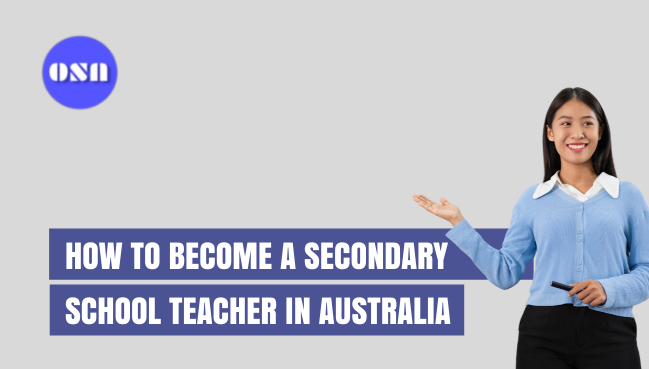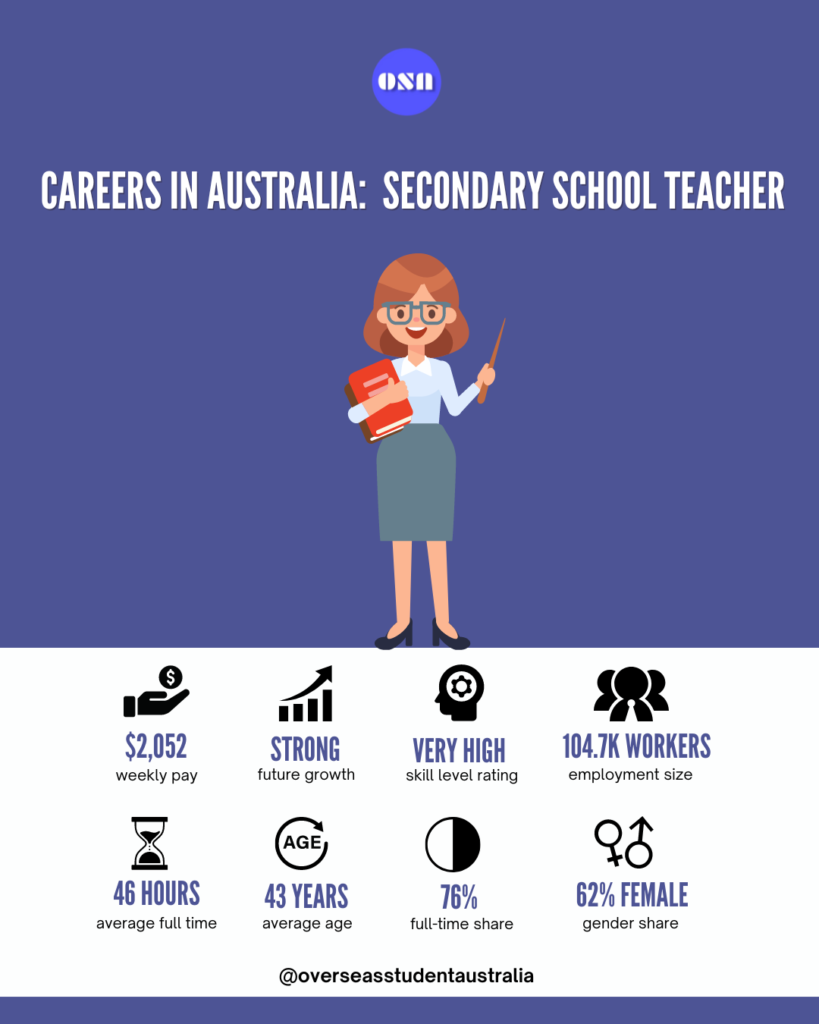How to Become a Secondary School Teacher in Australia With Salary Guide

Do you have a strong appetite for imparting knowledge? Ever thought you could become a teacher in Australia?
If you have a passion for education, then becoming a Secondary School Teacher might be your perfect career.
In this blog post, we will be discussing everything you need to know about how to become a Secondary School Teacher in Australia.
Overview of Secondary School Teaching in Australia
Secondary School Teachers are educators who promote the academic progression and general well-being of young adults or teenagers. This general well-being includes their physical, social, psychological, and emotional development.
They teach one or two subjects to students based on their area of ability, skills, knowledge and adhere to the school curriculum and guidelines. They may also handle supervising extracurricular activities and working extra hours teaching.
This career is a highly respected profession and is also expected to have good projected growth by 2026.
Size of the industry
Around 140,700 Secondary School Teachers are employed in the Australian Workforce.
Statistics show that this profession is expected to have a promising projected growth of 3.7% by 2026, making this a decent and credible career path to follow.
Popular locations
It is estimated that 41% of Secondary School Teachers live in the capital cities compared to the all-job average of 38%.
New South Wales and Victoria have the largest share of employment relative to their population size.
Here below is the percentage of Secondary School Teachers in different areas of Australia by state and territory:
- New South Wales 33.5%
- Victoria 26.4%
- Queensland 19.0%
- South Australia 6.3%
- Western Australia 10.2%
- Tasmania 2.2%
- North Territory 0.7%
- Australian Capital Territory 1.7%
This is why it is necessary to consider a potential career path when selecting a city to study. Click here to find out how to choose a city to study in Australia.
Industries where Secondary school teachers are needed
An impressive 99.5% of Secondary School Teachers work in the education and training industries while some work in other industries such as:
- Public Administrative and Safety 0.4%
- Healthcare and Social Assistance 0.1%
- Public admin and healthcare accounts for the remaining 0.5%
Hours of work
In Australia, around 76% of Secondary School Teachers work full-time hours. This is 10% above the all-jobs average of 66%. Full-time workers work an average of 46 hours a week, which is similar to all jobs that average 44 hours a week.
More than a third of these professionals regularly work overtime or extra hours (either paid or unpaid).
Age
The average age of Secondary School Teachers is 43 years, this is higher than the average of all-jobs average of 40 years.
A large ratio of Secondary School Teachers is within the age bracket between 25–34 years.
Gender
With more than 140,700 Secondary School Teachers in Australia, women account for 62% of the workforce, while men account for the remaining 38% of the workforce.
What are some skills needed to become a secondary school in Australia?
Here are some skills needed to become a Secondary School Teacher in Australia:
- Active listening
- Writing
- Instructing
- Monitoring
- Critical Thinking
- Active learning
- Time management
- Learning Strategies
- Social Perceptions
- System evaluation.
- Problem-solving
- Judgement and decision-making
- Reading comprehension.
What are the tasks and duties of a secondary school teacher?
The job of a Secondary School Teacher may range from making class lesson notes to even attending PTA meetings and arranging extracurricular activities.
Here are some of the tasks and duties performed by a Secondary School Teacher:
- Prepare daily lessons and long-term teaching plans according to the laws and curriculum of your state or territory.
- Conduct tests, assignments, homework, and projects.
- Correct and grade assessments, then arrange the outcomes.
- Organise non-teaching staff’s activities in schools and administrative support initiatives.
- In the absence of the professors, watch over additional courses.
- Use technology to help with lesson planning, reporting, and teaching.
- Connect with other educators.
- Take part in events like parent-teacher evenings and school council in collaboration with the school committee and parents.
- Do the necessary administrative tasks.
- Use a variety of teaching methods, taking into account the variations between each student, such as experiments, structured lessons, field trips and assignments, practical activities, conversations, and projects.
- Organise industry-related programs.
- Attend pupils in the yard during lunch or breaks.
- Together with other staff members, change the curriculum and policies of the school to reflect new government initiatives and the changing requirements of the pupils.
- Attend staff meetings, educational seminars, and other professional development events.
- Discuss specific problems and performance with parents and kids, as well as report and assess the progress of the class.
- Take part in remote learning (for instance, teaching using television transmission, radio, audiovisual, correspondence, and other multimedia resources).
- Assistance in planning athletic events, camping vacations, and other outings.
- Set up and maintain healthy working practices as well as school-wide discipline.
How much does a secondary school teacher earn?
On average, the full-time earnings of a Secondary School Teacher are $2052, which is higher than all jobs’ pay of $1593.
The average hourly pay is $56, which is more than all jobs’ hourly pay of $41.

Essential steps to becoming a secondary school teacher in Australia?
Here is the step-by-step process to becoming a Secondary School Teacher in Australia.
Step 1: Acquiring a degree in Education (secondary)
To work as a Secondary School Teacher in Australia, you should have a bachelor’s degree in Education as a minimum qualification.
Bachelor of Education (Secondary)
To enrol in an undergraduate Education (secondary) degree at an accredited Australian university, you must have completed high school.
International students must also meet several requirements before applying to study Education in Australia including::
- Year 12 completion certificate
- An English proficiency test with the band score the intended university requires (IELTS, TOEFL, PTE). (Use this if you’re a student from a country that isn’t fluent in English.)
A Bachelor’s degree in Education (Secondary) is a 4-year full-time study course.
The average cost for acquiring an Education bachelor’s degree ranges from AUD25,000-50,000 to study in Australia.
Masters of Teaching (Secondary)
You may pursue a master’s degree after receiving a bachelor’s degree in Education or a closely related discipline that you would like to teach.
A Master’s degree in Teaching (Secondary) can be earned in 2 years of full-time study.
If you want to apply for an Education master’s degree in Australia, you also need to meet certain requirements.
- An English proficiency test with a band score accepted by the intended institution of study (IELTS, TOEFL, etc.).
- Have worked for two to three years (Not mandatory but recommended).
- Bachelor’s degree
The yearly tuition fee for a Master’s degree in Australia normally costs AUD 30,000 to $40,000.
Important note for international students:
If you are planning to become a secondary school teacher in Australia, then you will need to undertake an English test like IELTS with (with a minimum score of 7.0 in Reading and Writing and 8.0 in Speaking and Listening).
Exemption from English Test for international students:
You are exempt from an English Test as an international student if you have already completed 4 years of higher education (university) in Australia, Canada, Ireland, New Zealand, UK or USA.
Step 2: Get the Teacher’s registration
After receiving a degree in Education (secondary), the next step is to apply to the Department of Education in your Australian region, state, or territory for getting a Teacher’s registration.
You need to maintain your teacher registration for the whole duration of your teaching career in Australia.
Step 3: Get your Working with Children Check
In some states and territories, you will be required to get a working with children check in order to work with young children.
Working with Children Check is a screening process for any person who is going to work with children in Australia to check any criminal history and professional misconduct.
Step 4: Apply for jobs
Once the above-mentioned steps have been completed, you can apply for jobs in your state government or private schools.
There are many types of career opportunities available for secondary school teachers, including leading teacher, special education teacher and principal.
Step 5: Join an Australian Teaching Association
You might also think about joining one of Australia’s teaching organisation bodies to keep yourself updated with the regular professional development.
There are many educational associations in Australia; however, the following are a few to note:
- Australian College of Educators
- The Australian Education Union
- Australian Teacher Education Association
- The Australian Council for Educational Leaders
An annual fee of $35 to $100 is required to join these associations.
What are the popular universities to study Degree in Education (Secondary) in Australia?
Here is a list of some popular universities to study a degree in Education (Secondary) in Australia:
- University of Melbourne
- James Cook University
- University of Sydney
- Edith Cowan University
- University of South Australia
- Swinburne University
- Deakin University
Future growth of secondary school teaching in Australia
This professional career has a good projected growth of 3.7% up to 2026, making it a dependable career choice.
Being a Secondary School Teacher requires the ability to use critical thinking and decisiveness to promote young adults’ cognitive psychology, and emotional, and physical development.
This may not be as easy as it seems, but through passion and keen nature to understand perspectives from their views, you can be able to get through them.
That’s everything you need to know about becoming a secondary school teacher in Australia. Let us know what career you want us to cover next in the comment section below.


